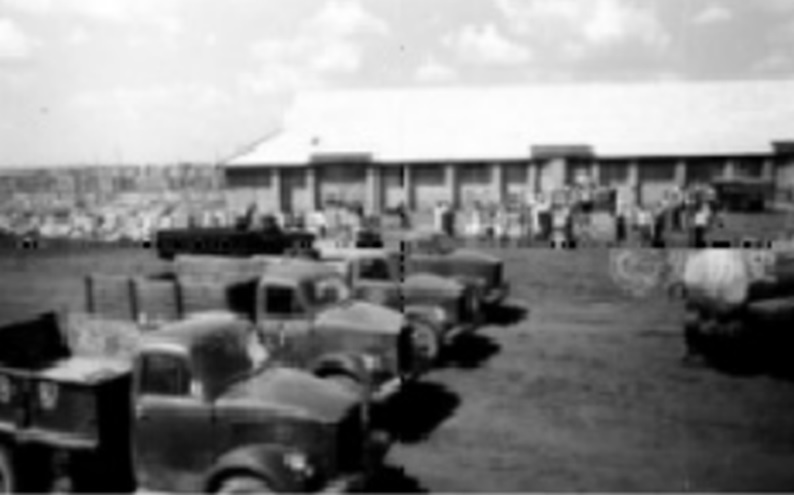配合饲料厂
院士楼 松江县配合饲料厂旧址
此处为院士楼,它的前身是松江县配合饲料厂,是上海第一家自行设计、全部国产设备、全钢架结构的新型饲料厂。1988年4月投产,年产饲料能力4万吨。时任中共中央政治局委员、上海市委书记、市长江泽民为该厂题写厂名,并题词:“振兴饲料工业,为发展副食品生产服务”,表示祝贺和鼓励。
云间粮仓建成后,计划设立两院院士联合工作站、诺贝尔自然科学奖纪念馆、两院院士艺术馆,同时还将设立两院院士文献资料中心,收录两院院士手稿、著作等。
This is the academician building. Its predecessor is Songjiang compound feed factory. It is the first new feed factory in Shanghai with self-designed and all domestic equipment. Jiang Zemin Secretary of the Shanghai municipal Party committee and mayor, wrote the name of the plant: "revitalize the feed industry and serve the development of non-staple food production".
After the completion of Yunjian granary, it is planned to set up a joint workstation for academicians of the two academies. At the same time, it will also set up a literature center to collect their manuscripts and works.
打卡地拍摄指南:
院士楼作为云间粮仓的一个重要建筑,是能够体现松江科技与创新的场所,是具有学术氛围的区域,可以从各个角度体现其建筑风貌。在适当的距离,采用低角度拍摄,将整幢建筑放置在画面中,构建出屹立的院士楼。
Academician building is a place for Songjiang scientific and technological innovation, which can reflect its architectural style from all angles. At an appropriate distance, place the whole building in the picture.
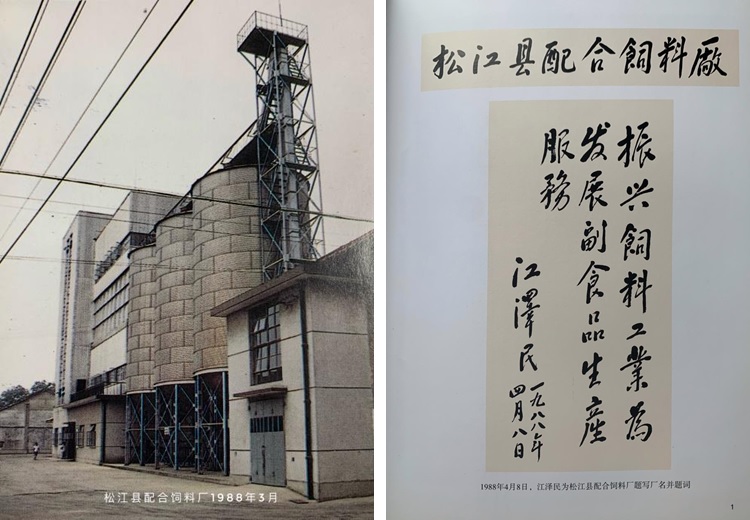

改造前的院士楼

改造后的院士楼
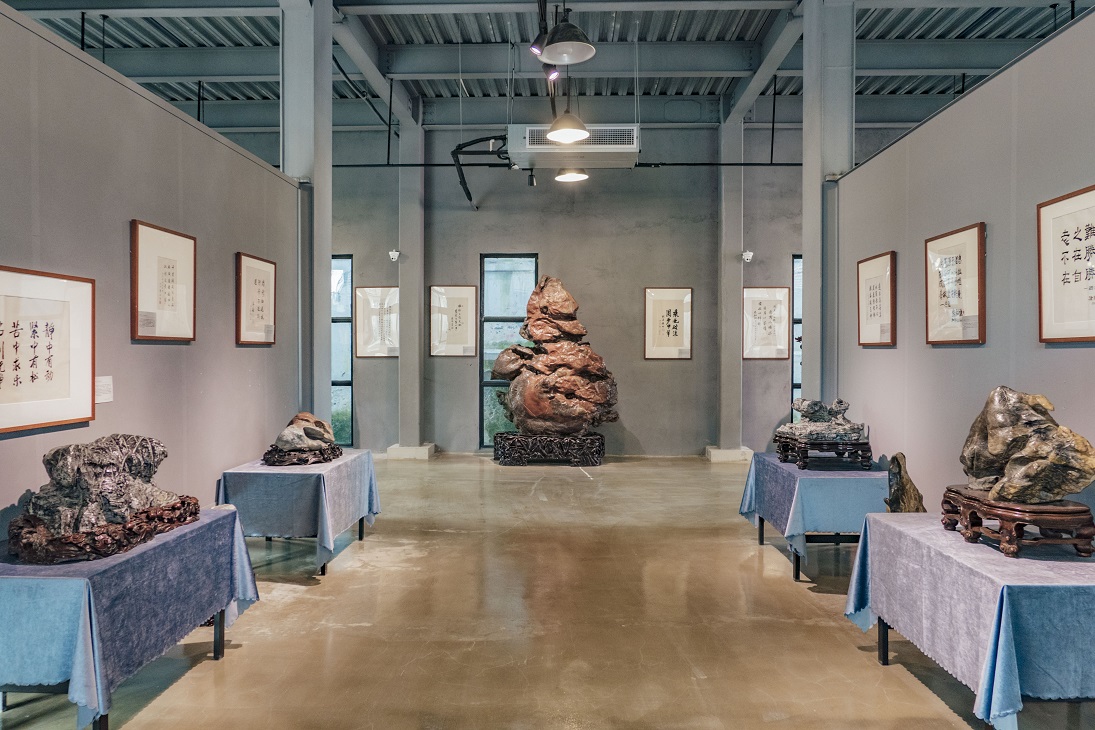
打卡贴士指导:
目前两院院士艺术馆已正式对公众开放,在院士楼四楼长期陈列,这些院士不仅是科学领域的泰斗,更深谙中华传统文化,他们的书画作品不仅有较高的艺术水准,还彰显了科学家们至善至美的精神境界与性情修养。
At present, the academician Art Museum of the Chinese Academy of Sciences has been officially opened to the public and has been displayed on the fourth floor of the building for a long time. These academicians familiar with Chinese traditional culture, and their painting works have a high artistic level.
地磅
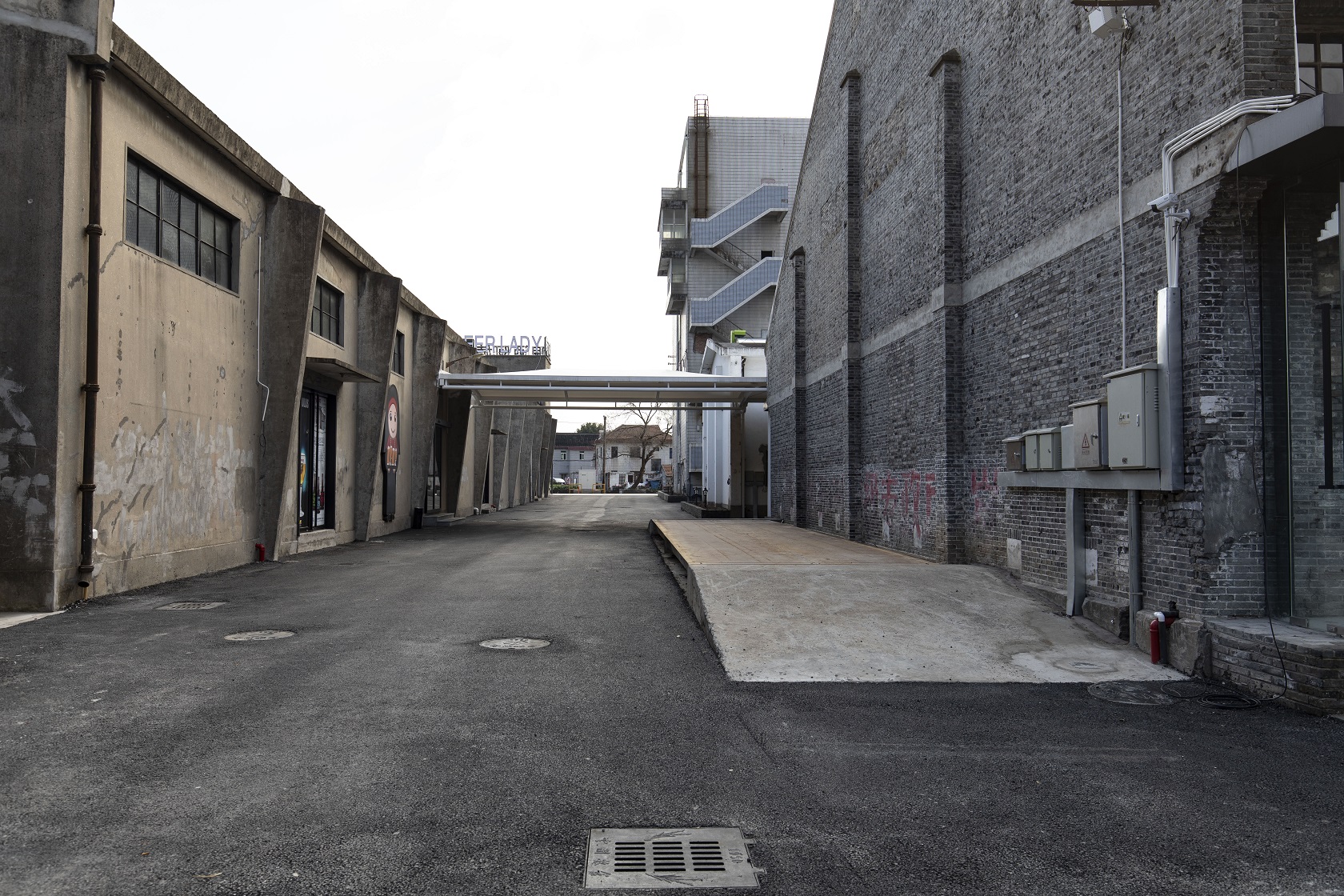
改造前的地磅

改造后的地磅
地磅
地磅是粮仓专用磅秤。粮食装仓前,要过多道关卡,需要检验粮食的品质,还必须过磅,准确称量粮食的重量。目前比较常见的地磅有工字钢地磅、T型梁地磅、U型钢地磅、槽钢地磅等。云间粮仓的地磅为工字钢地磅。工字钢地磅,顾名思义,即截面为工字形的长条钢材,由于抗压、承受力强,并且秤体不容易出现故障,是上选。
The scale is a special scale for granary. Grain loading, to go through a number of checkpoints, need to test the quality of grain, but also must weigh the weight of grain accurately. At present, the more common weighbridge I-steel Weighbridge, t-beam weighbridge, u-steel weighbridge, channel steel weighbridge and so on. The scale of Yunjian granary is i-beam scale. I-BEAM weighbridge, as the name implies, that is, section for i-shaped strip steel, due to compression, strong resistance, and scale body is not prone to failure, is selected.
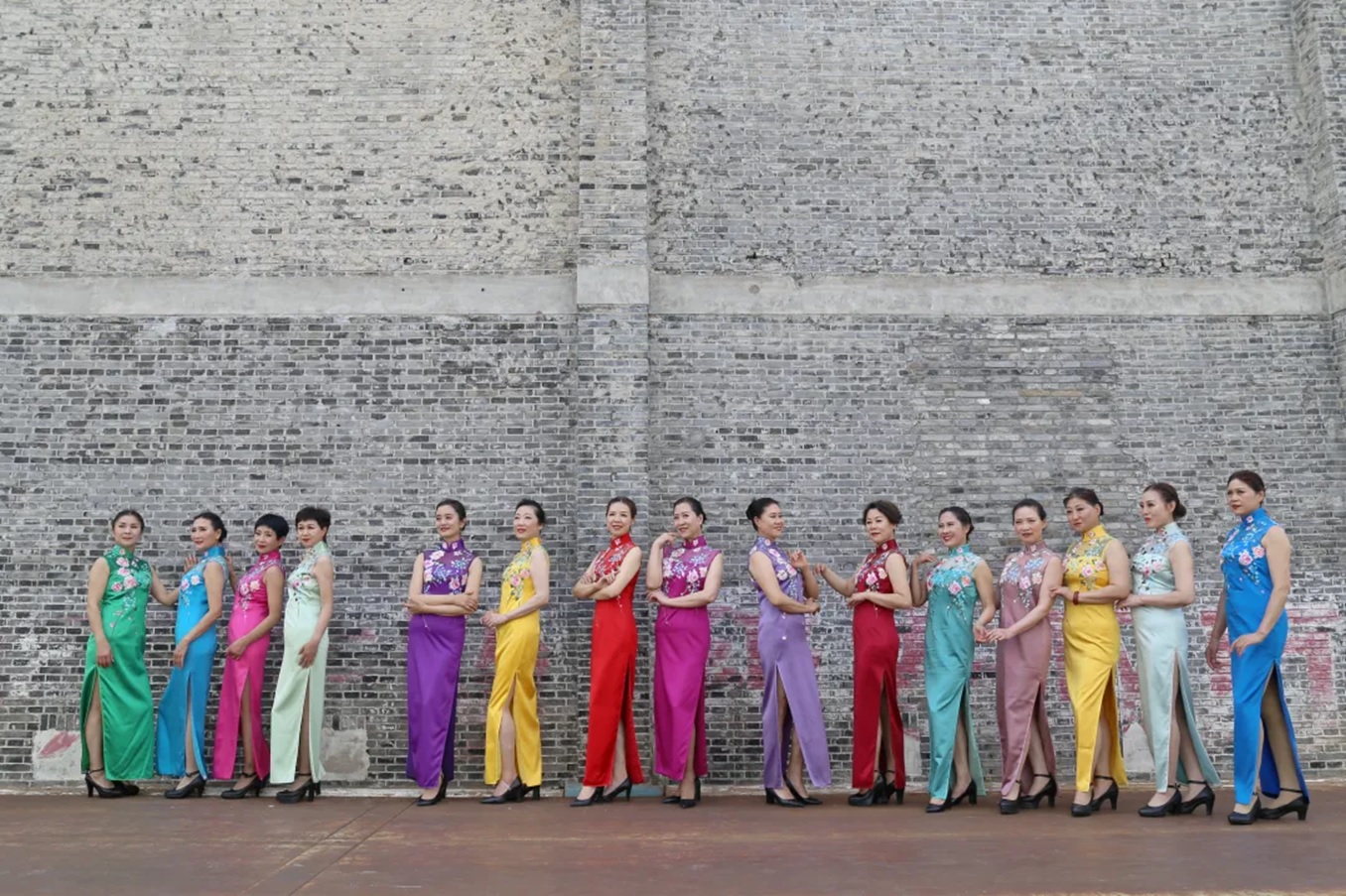
打卡地拍摄指南:
红色的字迹印在灰白色的墙上,因历史的痕迹让字迹变得不那么清晰。下方的地磅呈长条形,可以从侧面进行拍摄,获取更加完整的构图,或是正对拍摄,将文字与地磅横平竖直地放置在画面中,更好地凸显其历史悠久的感觉。
The Red Lettering is printed on the gray and white walls, which are blurred by the traces of history. The scales below are long and can be shot from the side for a more complete composition, or taken in the right direction, with text and scales placed horizontally and vertically in the frame to give a better sense of its age.
筒仓
立式筒仓
面粉厂的第一道工艺流程就是筒仓系统。它主要负责小麦的存储和初次清理。筒仓系统主要由卸粮坑、工作塔和筒仓组成。其中,筒仓主要用来贮存粮食、饲料等粒状和粉状物料,它的平面形状有正方形、矩形、多边形和圆形等,由于圆形筒仓仓壁受力合理,用料经济,所以应用最广。云间粮仓拥有上海市罕见的五层高筒仓,八栋筒仓是园区最富特色的建筑,高24米,单个筒仓直径5.5米,这里主要供面粉厂存储小麦等物资,为面粉的生产做储备。
Silos are mainly used to store grain, feed and other granular and powdery materials, its plane shape has square, rectangle, Polygon and circle, and so on. Yunjian granary has a rare five-storey silo in Shanghai. The eight silos are the most distinctive buildings in the park, mainly for flour mills to store wheat and other materials.
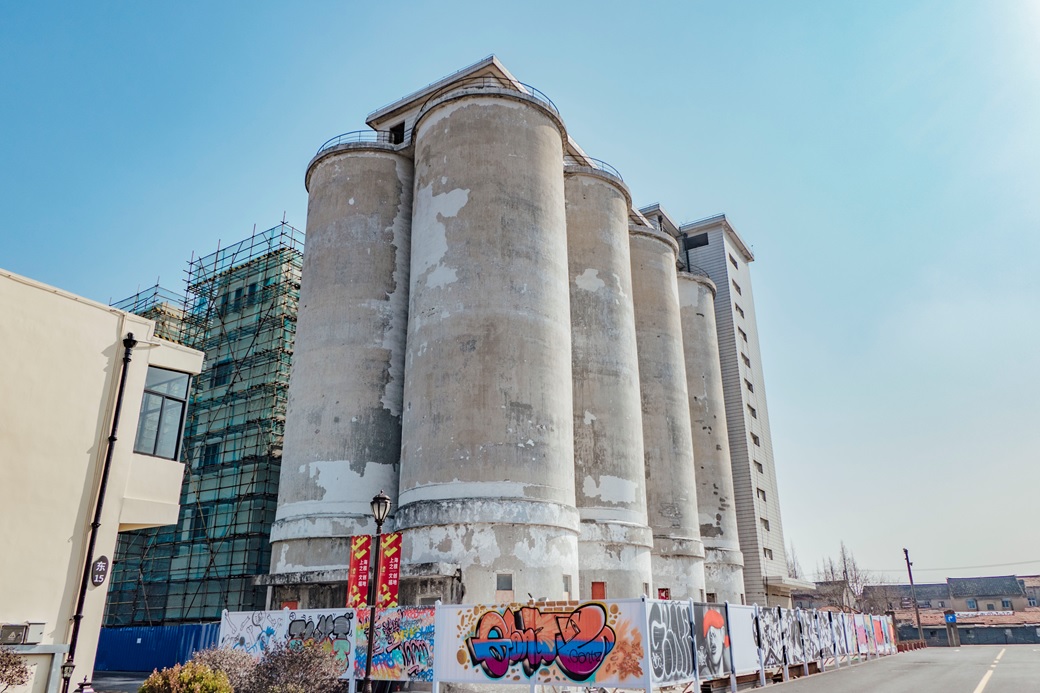
改造前的筒仓
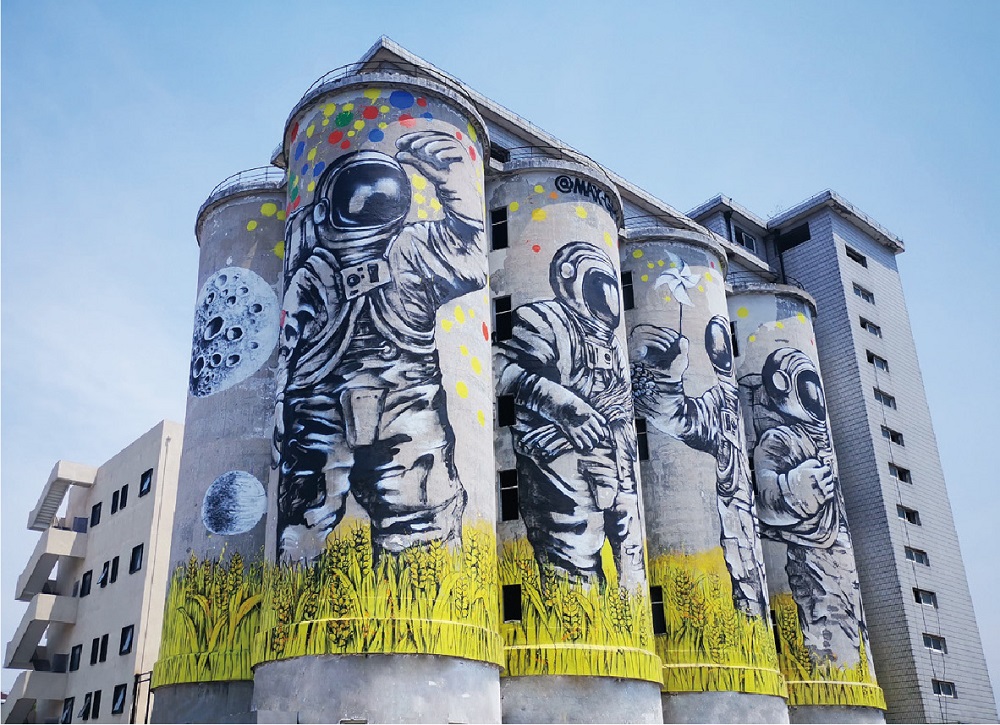
改造后的筒仓
粮食储藏
1953年,全松江储存粮食7675万斤。后随着农业生产的发展,1956年,储存粮食已接近2亿斤;1965年到1985年的21年中,全县年均储存粮食均超亿斤,其中有9年超过2亿斤。
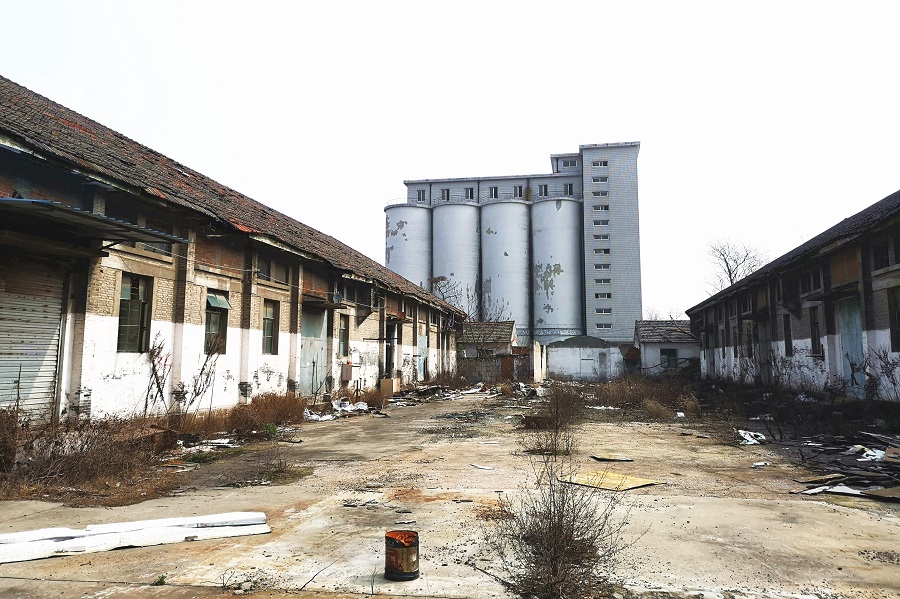
改造前的筒仓
粮食转运
松江地处平原,河道纵横,为粮油饲的运输提供了方便,尤其利于船运。松江是产粮区,又是余粮县,这决定了松江的粮食是大量调出和少量调入。
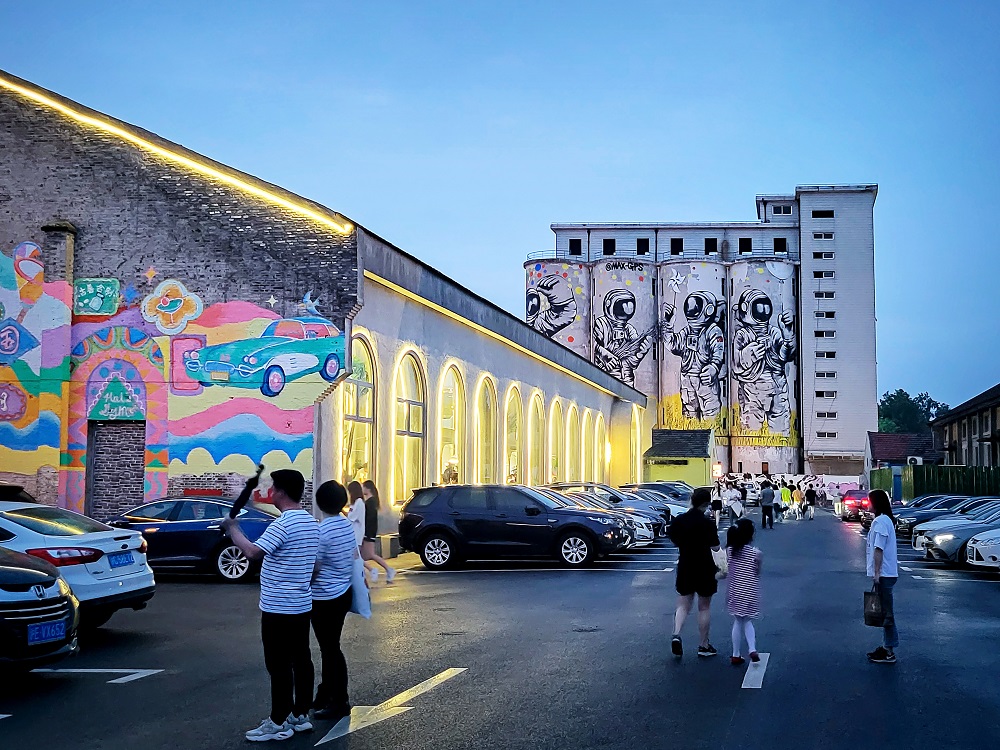
改造后的筒仓夜景
晒粮演进
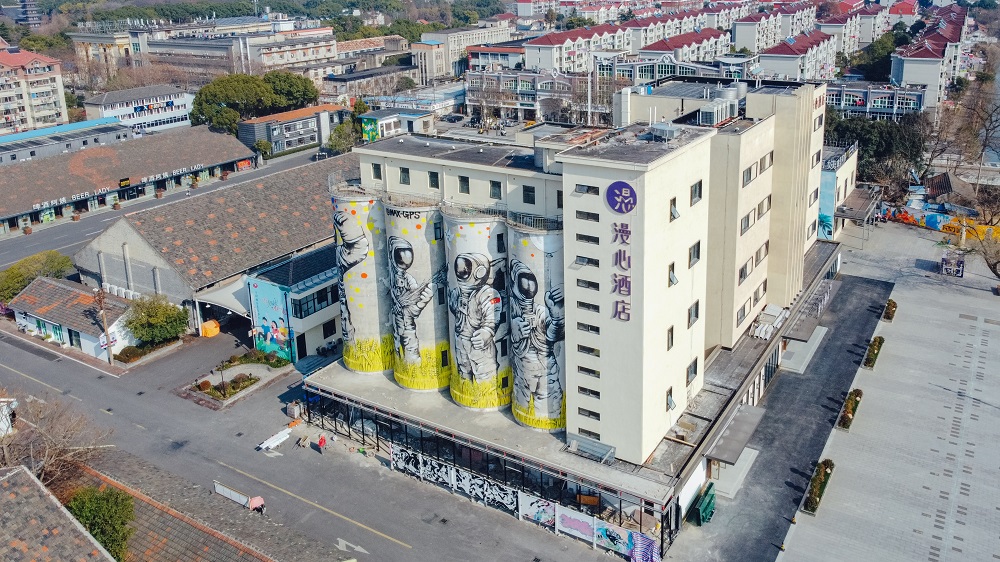
打卡地拍摄指南:
筒仓的拍摄可以从不同角度获取风格各异的构图,若从筒仓的侧面拍摄,可以很好地拍摄到五层高筒仓的整体效果,八栋整齐排列的圆形筒仓呈4X2分布。若从远处的粮仓间拍摄,可以将筒仓建筑与粮仓建筑形成鲜明对比,高耸的筒仓与平矮的粮仓是园区一道亮丽的风景线。
Silos can be shot from different angles to obtain different styles of composition, high-rise silo and low granary is a beautiful landscape of the park.
苏式粮仓
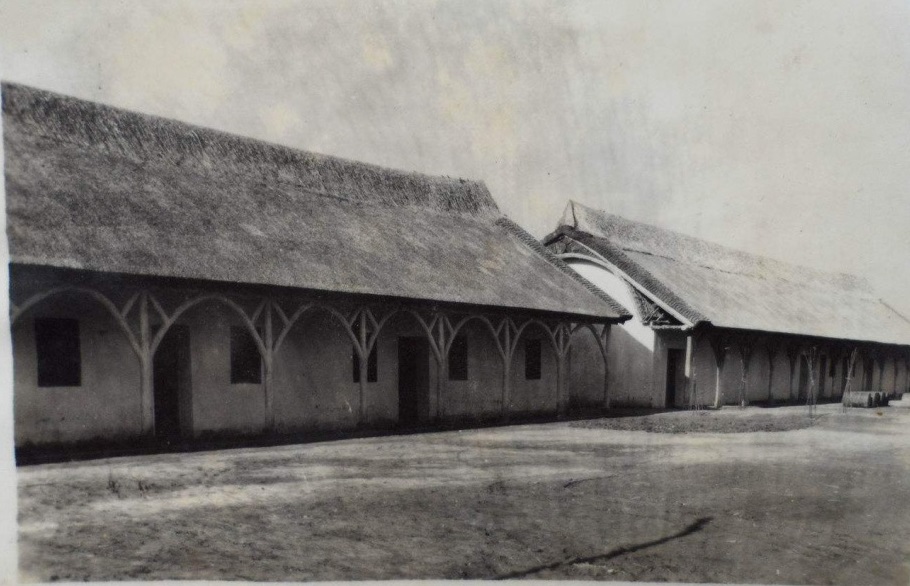
苏式粮仓旧址
松江素有“鱼米之乡”的美誉,明清两代,松江是江南的储粮重地,米业兴旺,漕舟云集,水运繁忙。解放以后,云间粮仓开始承担松江粮食存储的重任。1950年下半年,中粮松江支公司在县城南门新建3幢新型粮仓,容量540万公斤,定名为第一仓库。1953年4月,第一仓库与松江专署粮食局直属粮库合并,更名南门粮库。
这些沿河而建的苏式粮仓,是建国以后松江地区粮食集中储存和运输中转的重要设施,从保存数量和体量上足见其当年的盛大规模。它们形制特殊,反映了新中国建立之初模仿苏联工农业建设的历史。同时,建筑本身亦具有较高的科学研究价值。
During the Ming and Qing dynasties, Songjiang District was a major grain storage area in the south of the Yangtze River. After liberation, Yunjian granary began to take on the responsibility of grain storage in Songjiang District. In the second half of 1950, COFCO Songjiang Branch built 3 new granaries with a capacity of 5.4 million kg at the south gate of the county seat. In April 1953, the first warehouse was merged with the grain depot directly under the Food Bureau of the Songjiang District Special Administrative Region and renamed the Nanmen Grain Depot.
These soviet-style granaries along the river were important facilities for the centralized storage and transportation of grain in Songjiang District after the founding of New China. Their special forms reflect the history of imitating the construction of Industry and Agriculture of the Soviet Union in the early days of New China. At the same time, the building itself also has a high scientific research value.
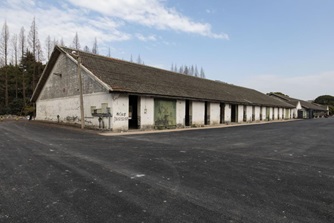
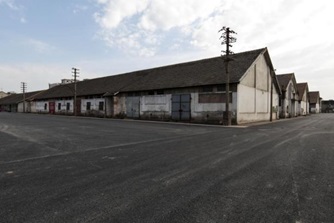
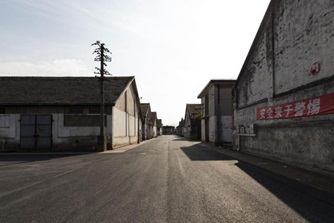
打卡地拍摄指南:
苏式粮仓可独幢拍摄或多幢拍摄,皆有各自风味。从侧面拍摄,将长条形的粮仓全貌囊括其中,亦可在两幢粮仓间进行拍摄,打造纵深感。
Soviet-style granary can be shot alone or multiple blocks, all have their own flavor. Shoot from the side, the whole picture of the long grain silos included, but also can be shot between two grain silos, creating a sense of depth.
松江面粉厂

面粉厂改造前
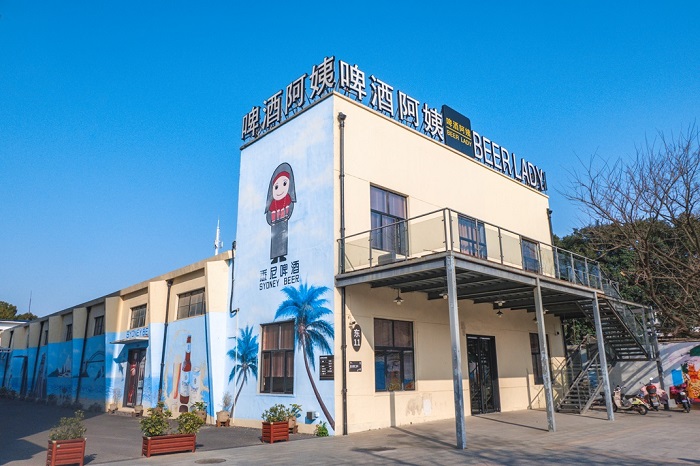
面粉厂改造后
松江面粉厂旧址
由啤酒阿姨打造的啤酒文化博物馆是目前沪上最大的啤酒博物馆,这里前身是松江面粉厂。1982年6月,上海市财贸办公室和上海市粮食局批准在这里新建年产37500吨的面粉厂一座。1984年6月,面粉厂一次试车成功,各项技术指标都达到和超过设计需求,从此结束了松江无面粉加工的历史。除了供应松江本地以外,还调拨及议价销售给福建、江西、吉林等十多个省市。面粉厂的销售较为可观,仅用一年零一个月的时间就收回了全部投资。1989年12月,松江面粉厂生产的“通宇牌”面粉荣获上海市粮食局优质产品称号。
The Beer Culture Museum, formerly known as Songjiang Flour Mill. In June 1982, the Shanghai Municipal Finance and Trade Office approved the construction of a new flour mill here. In June 1984, all the technical indicators met and exceeded the design requirements, and supply the local of Songjiang District. It took only a year and a month for the mill to recoup its investment. In December 1989, the "tongyu brand" won the title of Quality Product of Shanghai Grain Bureau.
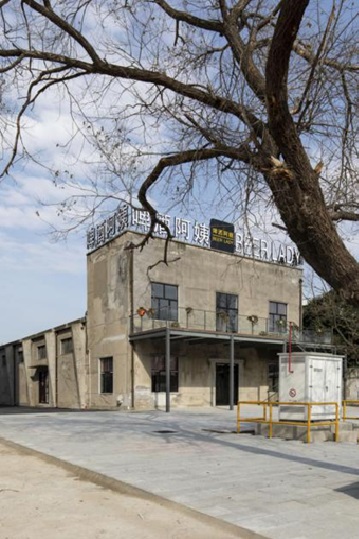
打卡地拍摄指南:
松江面粉厂,也就是现如今的啤酒文化博物馆,拍摄位置较多,可从正面拍摄整幢啤酒阿姨门面,也可进入拍摄室内环境,亦可从啤酒阿姨背面拍摄,正正方方的建筑物与“啤酒阿姨”、“BEER LADY”的标牌都引人注目,还可以利用后方的大树作为前景进行构图。
The Songjiang District Flour Mill, now known as the Beer Culture Museum, has a wide range of locations, including a front view of the entire building, an indoor environment, and a back view of the beer lady, the square buildings stand out with the BEER aunty and BEER LADY signs, and can be framed by the trees in the foreground.
简易仓(平房仓)旧址
简易仓(平房仓)旧址
根据农业和粮食的发展状况,国务院于 1983 年 11 月批准了粮食仓库、棉花仓库、水果仓库的“三库”建设,这是自“苏式仓”之后的一次统筹规划的大规模粮库建设,其中用于粮库建设的基建投资 16.5 亿元,建设总仓容 1500 万吨。仓型仍以房式仓为主,结构多为砖混结构,但是装粮高度一般为 4.5 米至 5.0 米,仓房跨度以 18 米、20 米为主。
The State Council approved in November 1983 the construction of "three warehouses" for grain warehouses, cotton warehouses and fruit warehouses. 1.65 billion yuan was invested in the construction of grain depots. Room type warehouse is still the main, most of the structure for brick-concrete structure, and 4.5 meters to 5.0 meters height, span to 20 meters mainly.
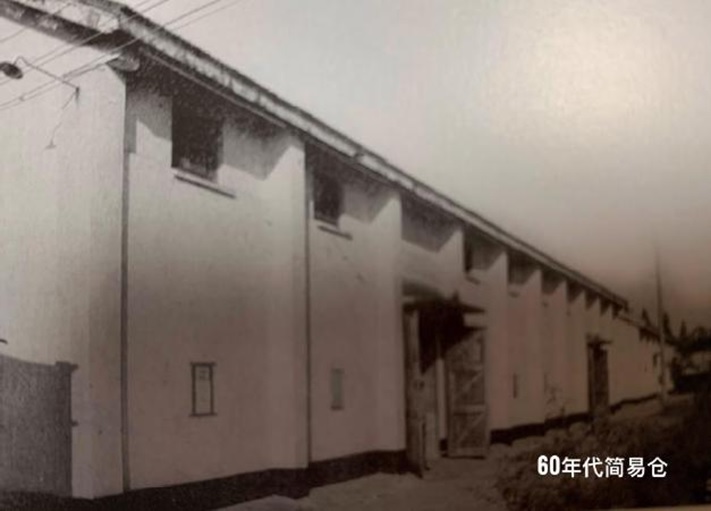

历史沿革:
我国的粮仓建设是以房式仓为主要仓型,据有关资料介绍,房式仓的容量占全国总仓容量的百分之八十以上,与其它主要仓型相比,房式仓具有投资少,设计和施工速度快、技术要求低、容易上马、能够适合包散两用等优点,但从粮仓现代化的长远观点来看,房式仓占地面积大,安全保粮条件差,实现全盘机械化比较困难,已被机械化程度较高的立筒仓所取代。
The construction of grain silos in our country is based on room type warehouse as the main type of silos. Compared with other main types of silos, house-type silos have less investment, fast design and construction speed, low technical requirements, easy mounting, and being suitable for both packing and dispersing purposes. However the house-type granary covers a large area and the conditions for safe and secure grain are poor, which has been replaced by vertical silos with high degree of mechanization.
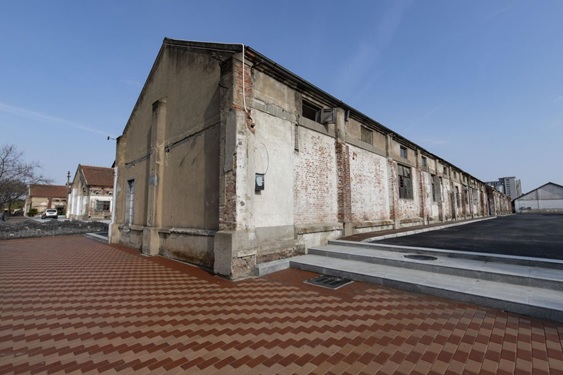
嘻谷艺术馆
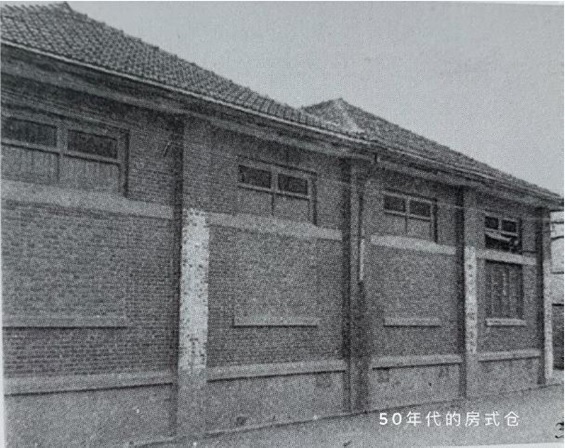
嘻谷艺术馆
根据农业和粮食的发展状况,国务院于 1983 年 11 月批准了粮食仓库、棉花仓库、水果仓库的“三库”建设,这是自“苏式仓”之后的一次统筹规划的大规模粮库建设,其中用于粮库建设的基建投资 16.5 亿元,建设总仓容 1500 万吨。仓型仍以房式仓为主,结构多为砖混结构,但是装粮高度一般为 4.5 米至 5.0 米,仓房跨度以 18 米、20 米为主。
In accordance with the development of agriculture and grain, the State Council approved in November 1983 the construction of "three warehouses" for grain warehouses, cotton warehouses and fruit warehouses. This is a large-scale grain depot construction planned in an overall way after the "Soviet-style granary" , of this total, 1.65 billion yuan was invested in the construction of grain depots and 15 million tons were built in the warehouses. Room type warehouse is still the main, most of the structure for brick-concrete structure, but generally 4.5 meters to 5.0 meters grain loading height, warehouse span to 18 meters, 20 meters mainly.
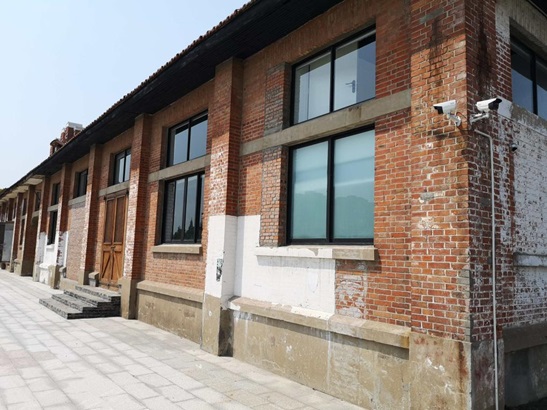
历史沿革:
我国的粮仓建设是以房式仓为主要仓型,据有关资料介绍,房式仓的容量占全国总仓容量的百分之八十以上,与其它主要仓型相比,房式仓具有投资少,设计和施工速度快、技术要求低、容易上马、能够适合包散两用等优点,但从粮仓现代化的长远观点来看,房式仓占地面积大,安全保粮条件差,实现全盘机械化比较困难,已被机械化程度较高的立筒仓所取代。
The construction of grain silos in our country is based on room type warehouse as the main type of silos. According to relevant information, the capacity of Room type warehouse accounts for more than 80 percent of the country's total warehouse capacity. Compared with other main types of silos, house-type silos have less investment, it has the advantages of fast design and construction speed, low technical requirements, easy mounting, and being suitable for both packing and dispersing purposes. However, from the long-term point of view of the modernization of Granary, the house-type granary covers a large area and the conditions for safe and secure grain are poor, it is difficult to realize total mechanization, which has been replaced by vertical silos with high degree of mechanization.
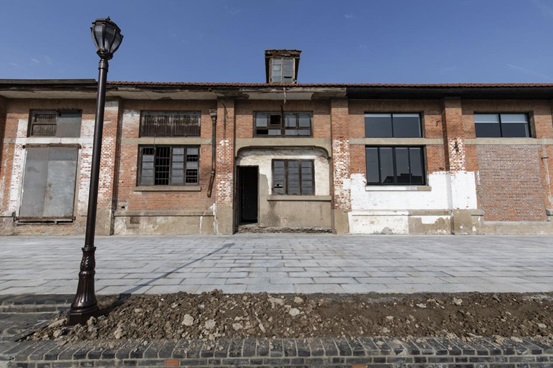
土圆囤旧址
土圆囤旧址
上世纪七十年代,这里建造了不少圆筒尖顶的仓库,被称之为“土圆囤”,专门用来储存粮食。
土圆囤是中国粮食仓储历史中的这一大创举,其穹顶设计利于排水,穹顶最上方和圆形墙体高处分别建有通风窗口,粮仓下方四周分布多条排水沟,粮仓前是一个大院坝,用于晾晒粮食。整个建筑设计布局很是巧妙,通风、采光、排湿、防火、防水都衔接得一丝不差。土圆仓的仓体较高,通常会修两道门,一上一下。上面的门用于进粮,下面的门用于出粮。1969年秋,松江推广黑龙江省明水县采用“一把泥,一把草,泥草混合,建造土圆囤”的经验。建造一座内径8米的土圆囤只需要10平方米油毛毡,0.3立方米木材,0.2吨水泥,6.3公斤白铁皮。在当时物资匮乏的年代,是解决国库仓容严重不足的办法之一。但土圆囤适用于少雨干燥地区,由于松江多雨,湿度高,兴建一二年后便相继倒塌、拆除。至1982年末,全县共存土圆囤115只,其中松江米厂78只。
In the 1970s, a number of spire-topped storage, known as "Earth bin" , used to store grain.
Earth bin is a great initiative in the history of grain storage in China.The dome is designed for drainage, Several drainage ditches are distributed around the granary. In front of the granary is a large courtyard dam for drying grain. The whole architectural design layout is conducive to ventilation, lighting, moisture drainage, fire prevention and water proofing. In the autumn of 1969, songjiang popularized the experience in mingshui county, heilongjiang province. It takes only 10 square metres of linoleum, 0.3 cubic metres of wood, 0.2 tonnes of cement and 6.3 kilograms of tin to build an 8-metre round tank. In those times of scarcity, it was one of the solutions to the severe shortage of Treasury space. However, the Earth Bin is suitable for dry areas with little rain. Due to the rainy and high humidity in songjiang, it collapsed and was dismantled after one or two years of construction. By the end of 1982, the county coexisted with 115 tuyuantun, including 78 from songjiang rice factory.

历史沿革:
如今这里已改造为知名运动品牌洛克公园的篮球馆,篮球馆面积为2600平米,是全国最大的洛克公园篮球馆,这里不仅配备了专业灯光和音响系统,还有洗手间可供洗浴,同时每季还会邀请职业联赛的专业球员举办相应体育活动,俨然成为球迷们的一大“打卡地”。
Now it has been transformed into the basketball hall of Rucker Park, a well-known sports brand. The basketball hall covers an area of 2600 square meters. It is the largest Locke Park Basketball Hall in China which seems to be a big "punch in place" for fans.
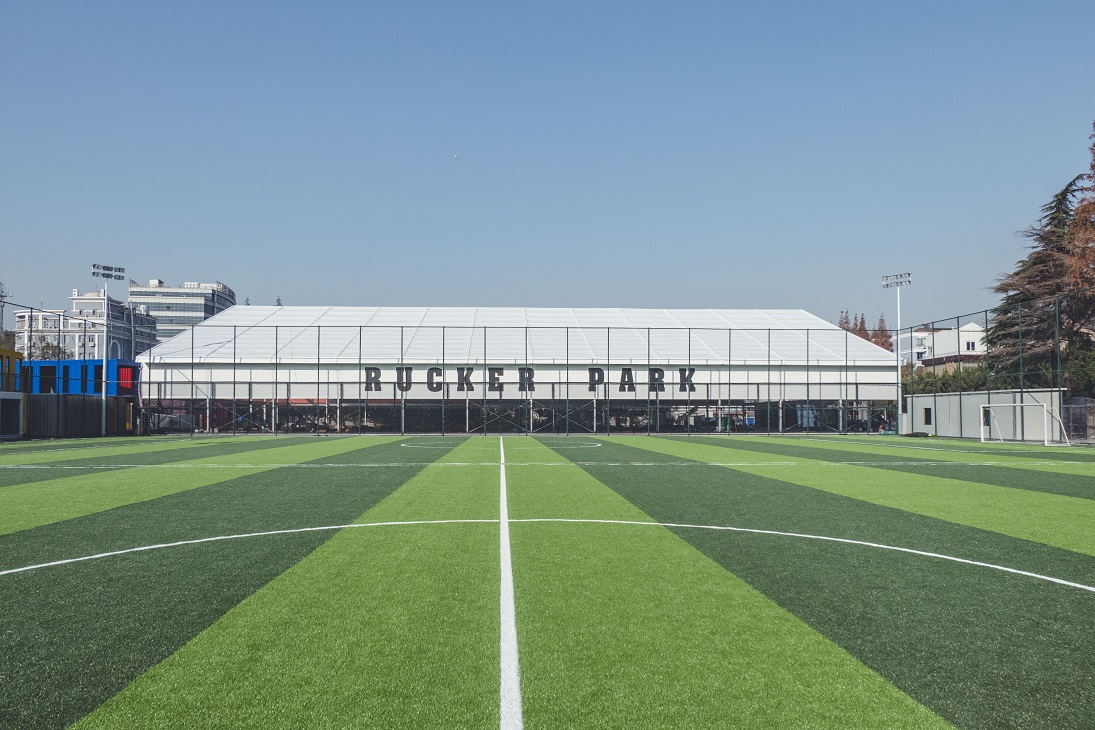
松江米厂旧址
松江米厂旧址
松江米厂原名叫“松江第一碾米厂”,和松江油脂化工厂是一个院落,原先的松江油脂化工厂仅是松江第一碾米厂中的一个车间,厂址就在通波塘对面,这里曾建桥联通两岸,与粮库所在地隔河相望。后来对面改建为生活小区,桥也被拆除了。
Songjiang Rice Mill, formerly known as "the first rice mill of Songjiang District" , is a compound of the oil and fat chemical plant in Songjiang District. The former oil and fat chemical plant in Songjiang District is only one workshop of the first rice mill in Songjiang District, which is located opposite to Tongbotang, a Bridge was built to connect the two banks, across the river from where the grain depot is located. It was later converted into a residential area across the street and the bridge was demolished.

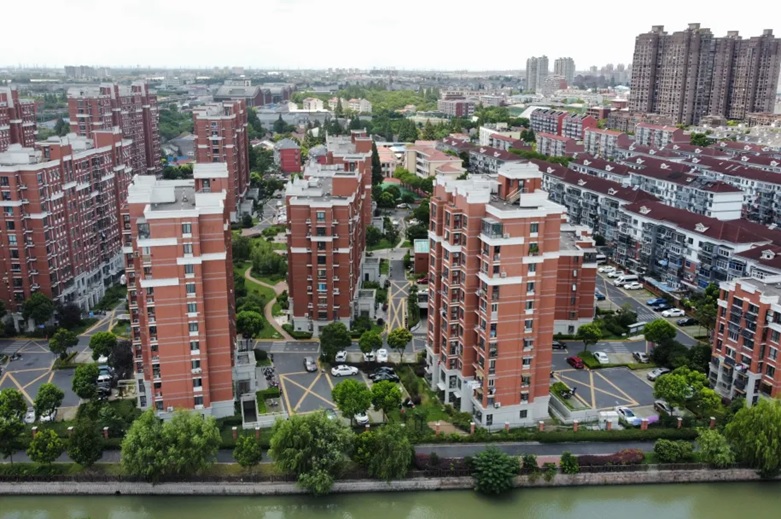
历史沿革:
1969年12月,南门粮库与松江第一米厂合并,更名松江米厂,主要负责粮食收购、调运、储存、加工。
1977年,松江米厂新建白酒车间,利用稗子、秕谷和糠糟制白酒。至1981年,共生产白酒60万公斤。
1979年2月松江米厂主车间及成品仓库划给油脂化工厂。
In December 1969, the Nanmen Grain Depot merged with the first rice mill of Songjiang District, renamed Songjiang Rice mill, mainly responsible for grain purchase, transportation, storage, processing.
In 1977, Songjiang Rice mill built a new liquor workshop, using Barnyard Millet, blighted grains and bran grains to make liquor. By 1981,600,000 kg of Baijiu had been produced.
February 1979 Songjiang Rice mill owner workshop and finished goods warehouse assigned to the oil and fat chemical plant.
